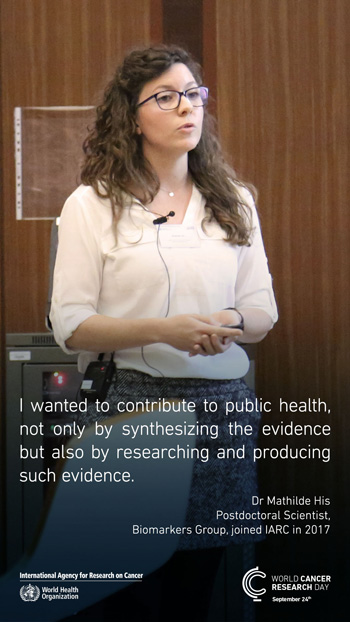❝I wanted to contribute to public health, not only by synthesizing the evidence but also by researching and producing such evidence.❞
Please introduce yourself. How long have you worked at IARC, and where did you work before?
My name is Mathilde His. I came to IARC as a postdoctoral scientist in the Section of Nutrition and Metabolism (NME) three years ago after completing a PhD in Epidemiology and Public Health at the French Institute of Health and Medical Research, near Paris. Originally, I trained as an engineer specialized in human nutrition.
What are the most interesting projects you are currently involved in, and why are they important?
Although breast cancer is one of the most heavily studied cancer types, a large proportion of new cases remain unexplained. I’m working on various projects trying to identify and better understand the causes of breast cancer, in particular by looking at lifestyle factors such as obesity. Some of my work uses recently developed tools to identify molecules in blood that are related to breast cancer, and to study whether these molecules could help guide future research on behaviours and lifestyle factors not yet known to be related to breast cancer risk.
I also work on studies that aim to understand breast cancer in low- and middle-income regions, where very few studies have been conducted so far, despite the rapidly growing burden of breast cancer associated with rapid changes in lifestyles. Working locally in these regions is crucial to understand what is going on.
What do you do when you’re not doing research at IARC?
You might find me at a dance class, with diverse styles from modern jazz to Irish dancing; sewing clothes; in the middle of a DIY project; or more recently discovering the joy of growing plants on the balcony!
Why did you move into research?
I wanted to contribute to public health, not only by synthesizing the evidence but also by researching and producing such evidence. I’ve always been attracted to understanding the causes of diseases and how to avoid them.
Which personal scientific contribution are you most proud of?
I try to give a broader impact to science by working on improving communication. Of course scientists are not journalists, but I consider that it is part of our mission to communicate scientific knowledge to various audiences when the opportunities arise, and I’m glad that I can bring my tiny contribution through this. A simple message: it takes some effort but is accessible to any scientist, and the effort is worth the investment. It even led me to publish in Science!
What is something you do now because of research you’ve read?
I try to stay aware of trends in scientific communication, in particular via Twitter, a great tool for that. Last year, there was a huge buzz around #betterposter, a proposed new poster template to try to refresh poster sessions at conferences. I liked the idea, so I adapted the template, tried it, and I received positive feedback!
